
Wilderness Safaris Wins 2018 African Responsible Tourism Awards
April 23, 2018The Camping Files: Chrisna Greeff
April 24, 2018Text and photographs: Dirk Heinrich
Many challenges had to be overcome during the planning and building of the new ranger station and entrance gate in Khaudum National Park in north-eastern Namibia. The new station is close to the northern border and serves as the park headquarters. The old station and reception office is about ten kilometres away.Firstly, the 46-kilometre stretch leading from the B8 tar road south to the northern border of the park is a track of thick, soft sand, only suitable for off-road vehicles and a very slow pace. Secondly, the groundwater at the selected site is at a shallow eight metres below the surface, making it vulnerable to pollution. In order to safeguard the environment, the planners and builders had to find ways to minimise the network of tracks to and around the new station and the entrance gate and to ensure that the groundwater would not be polluted during the building phase and thereafter. At the same time costs had to be kept as low as possible, but all the necessary services had to be available upon completion of the project in this remote part of the Kavango East Region, and all kinds of rubbish, building waste and hazardous materials had to be collected and disposed of.Delivering all the building materials to the site was not an easy task, because it took a six-wheel-driven heavy transporter several hours from the B8 to where the new Khaudum station is situated in the park. Therefore it was decided to make bricks on site, which was cheaper but had to be planned carefully so that no polluted water would seep into the ground and mix with the groundwater resources. The wastewater from brick-making and cleaning the cement mixers were collected in a plastic-lined pond and some of it was reused after the fine sediments had settled at the bottom. Dried waste was eventually taken to Rundu for disposal. Strict measures were implemented to avoid any environmental pollution during the building stage.A total of 400 000 bricks, nearly 20 000 bags of cement and more than 8 million litres of water were used to build the station. On 26 October 2017, the new Khaudum station and entrance gate were officially opened by the Minister of Environment and Tourism, Pohamba Shifeta. Twenty-four houses, a workshop with wash bay/slaughter facility, a vehicle service pit and storerooms, a service block with an emergency generator and battery room where the electricity from solar panels is stored, an electricity control room, a vehicle store, administration building, a community room and a multi-purpose centre were built. The new park station is self-suffcient: electricity is produced by a solar system and water is pumped from a borehole on site
Most importantly, staff members have been trained (and continue to be trained until July this year) in housekeeping and preventative maintenance as well as waste management. There are manuals and activity schedules for everything. The staff members now ensure that all waste is treated as specified, taken out of the park at no extra cost and dumped at designated dump sites in the nearest town. To avoid additional costs, staff members have been instructed to take as much waste along with them when they travel to town.Plastic, paper, glass and metal are deposited in different containers which are taken to Rundu on a regular basis. There is also a special container for hazardous waste like batteries of all kinds, bulbs and any electronic parts. Used cooking oil is stored in special 25-litre canisters to prevent it from entering the wastewater system. Mechanical and motor oils are taken out of the park in 20-litre containers. Other waste like nappies, sanitary pads and condoms are burned in a small incinerator, because none of these items are allowed in the sewerage system either. Sewage is collected in a three-chamber system where the water remains for at least 36 hours for the biological cleaning process to start. Thereafter it is pumped through a containerised trickling filter treatment plant. Solids are then moved back into the chambers while the cleaned water can be used for future vegetable gardens and via an underground pipeline-system, it is channelled to indigenous trees which have been planted around the sports field and buildings. The new station was part of a project to build altogether 61 houses for MET staff in Khaudum on the northern border of the park, at Sikeretti at the southern border of the park and at Shisinze in Nkasa Rupara National Park in the Zambezi Region. The Kreditanstalt für Wiederaufbau (KfW), a German development bank, financed the project with N$ 107 million, and Namibia’s Ministry of Environment and Tourism contributed N$ 29 million.Initially designated as a game park in 1989, Khaudum was proclaimed a national park in 2007. The park covers 3842 km² of Sandveld, boasts 13 waterholes and is the only park where roan antelope can be found together with gemsbok in their natural surroundings. Several thousand elephants, as well as lion, giraffe, common eland, common tsessebe, reedbuck and wild dogs call this remote, wild park their home.
For more information on Khaudum and the adventure of exploring the park, click here.
This article first appeared in the Autumn 2018 issue of TNN.

